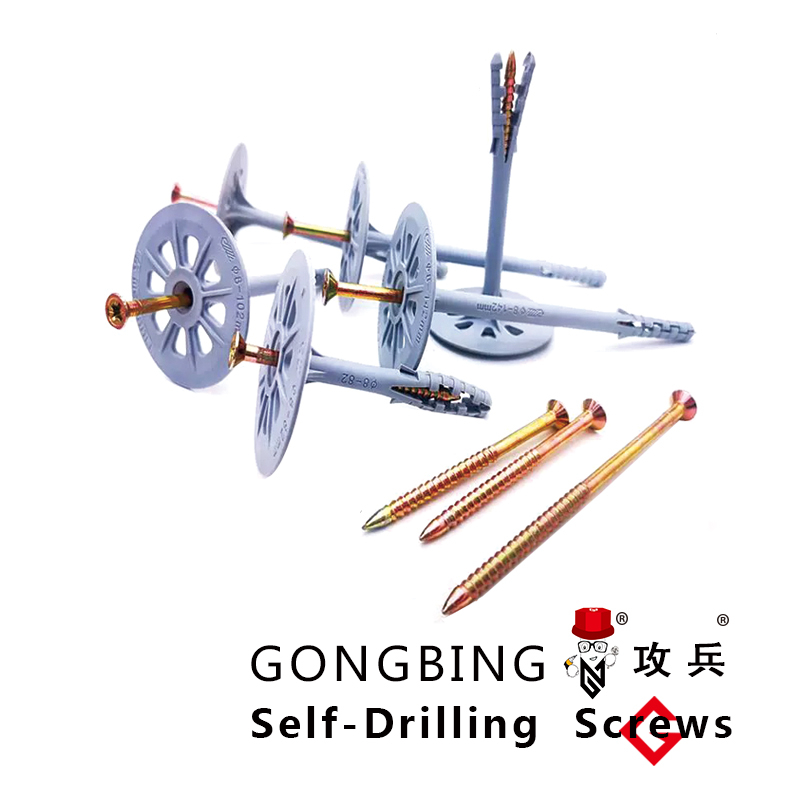Jul . 26, 2025 06:01
Back to list
High-Quality External Insulation Fixings for Lasting Performance
External Insulation Fixings: Industry Trends, Technical Parameters & Professional Insights
With global energy conservation becoming increasingly important, external insulation fixings, also known as insulation nails or insulation nails with washers, have become a staple in modern building envelopes. From residential high rises to commercial complexes, the performance of these fixings directly relates to the durability, safety, and thermal efficiency of entire insulation systems.
Industry Overview & Trends
The evolution of external insulation fixings reflects sweeping changes in energy codes, insulation thickness, environmental policies, and facade design. According to Insulation Institute Forum, demand in Europe and Asia-Pacific has surged due to tightening building regulations and incentives for improved thermal performance. Key trends include:
- Rise of eco-composite and anti-corrosive materials
- Growth in mechanically-fixed External Wall Insulation (EWI) systems
- Adoption of fasteners suitable for high wind loads and seismic zones
- Greater emphasis on long-term durability and minimal thermal bridging

Product Introduction: External wall insulation nails/ Nails for external wall insulation
Produced by Hebei xizhuo fastener co.,Ltd., the featured External wall insulation nails/ Nails for external wall insulation stand out for their unmatched performance:
- Manufactured with premium-grade, anti-aging materials
- Remarkable resistance to sudden temperature changes, corrosion, cold & heat cycles
- High-pressure bearing, excellent tensile strength
- Optimized for various insulation thicknesses and all major wall substrate types
Key Technical Parameters Comparison Table
| Parameter | Typical Range | Unit | Industry Standard | Relevance |
|---|---|---|---|---|
| Length | 60-220 | mm | ETAG 014:2013 | Insulation Thickness and Wall Depth |
| Disc Diameter | 50-90 | mm | EN 13163 | Fixation Area |
| Pull-out Strength | 0.5-2.5 | kN | ISO 8387 | Anchoring Reliability |
| Material | PP, HDPE, Nylon, Galvanized Steel | - | IEC 61386 | Mechanical & Chemical Resistance |
| Thermal Conductivity | ≤0.035 | W/m·K | DIN 4108-4 | Minimized Cold Bridging |
| Corrosion Resistance | Neutral Salt Spray ≥ 48h | - | ASTM B117 | Longevity in Harsh Environments |
| Installation Temperature | -30 ~ +60 | ℃ | Manufacturer Spec. | Seasonal Adaptability |
Visualizing External Insulation Fixings Technical Parameter Trends
Core Product Data: Performance Comparison & Visualization
Application Scenarios
External insulation fixings are engineered for:
- Systematic installation of external wall insulation boards (EPS, XPS, mineral wool, PUR, PIR, etc.)
- Facade retrofitting projects for energy upgrade
- Residential, public, commercial, industrial site applications
- High-rise buildings requiring wind suction resistance
- Environments with cyclic freeze-thaw or aggressive (marine/industrial) atmospheres
- Areas where mechanical fixing is required to meet building regulations
Professional FAQ: External Insulation Fixings Explained
Q1: What materials are commonly used in external insulation fixings?
A1: Standard materials include high-impact polypropylene (PP), polyethylene (PE), glass-fiber reinforced nylon, galvanized or zinc-plated steel. These offer superior chemical and mechanical resistance in diverse climates. Reference: NIA
Q2: What technical standards should insulation nails comply with?
A2: Compliance with ETAG 014, EN 13163, ISO 8387, and ASTM B117 is critical to ensure strength, durability, and corrosion resistance in building envelopes.
Q3: What are the main specification options for insulation nails (length, disc size, nail diameter)?
A3: Length: 60-220mm; Disc: 50-90mm diameter; Nail diameter: 4.5-6mm; which accommodate insulation thickness and wall substrate types.
Q4: How does anchor selection impact insulation system longevity?
A4: Quality anchors resist pull-out, thermal bridging, and corrosion, preventing insulation detachment and thermal losses. Attribute selection must match both insulation board and substrate.
Q5: What installation standards exist for mechanical fixings?
A5: Generally 5-8 fixings per m² for most EPS and MW systems, with denser patterns at corners and edges. Installations should follow supplier guidelines and locally relevant building codes (reference: BSI guidelines).
Q6: What is the function and benefit of insulation nails with washers?
A6: The washer flange increases fixation area, reducing risk of local pull-through and improving wind suction resistance especially on lighter or thick insulation panels.
Q7: Are there anti-aging or thermal break solutions for high-performance facades?
A7: Yes. Newer fixings use special polymers or built-in thermal breaks to minimize cold bridging and resist UV/salt spray degradation for >25 years’ life span.
Revealing the EEAT: Expertise, Authoritativeness and Trustworthiness
Hebei xizhuo fastener co.,Ltd. is recognized for state-of-the-art R&D and advanced fastener manufacturing. All products undergo stringent multi-parameter tests, with QA reports available on request. The engineering team follows leading industry associations such as the National Insulation Association and participates in global insulation engineering conferences.
Ordering & Technical Support
Feel free to contact us for customized sizes, bulk projects, or technical questions. Telephone direct hotline: +8613333101999
References:
[1] Insulation Institute Forum, External Wall Insulation Fixing Innovations
[2] NIA Technical Bulletin, National Insulation Association
[3] "Best Practices for Mechanical Fixings", International Journal of Building Envelopes, 2023, www.buildingenvelopejournal.com
[4] BSI Group, BSI: Building Standards
[1] Insulation Institute Forum, External Wall Insulation Fixing Innovations
[2] NIA Technical Bulletin, National Insulation Association
[3] "Best Practices for Mechanical Fixings", International Journal of Building Envelopes, 2023, www.buildingenvelopejournal.com
[4] BSI Group, BSI: Building Standards
Next:
This is the last article
Latest news
-
Weatherproof Plastic Expansion Anchors for OutdoorNewsJun.06,2025
-
Sustainability in the Supply Chain: Eco-Friendly TEK Screws ProductionNewsJun.06,2025
-
Load-Bearing Capacity of External Insulation FixingsNewsJun.06,2025
-
Double Head Bolts: Enhancing Efficiency in Industrial MachineryNewsJun.06,2025
-
Corrosion Resistance in Chipboard Screws: Coatings for Wholesale DurabilityNewsJun.06,2025
-
Butterfly Toggle Bolts : Enhancing Structural ResilienceNewsJun.06,2025
